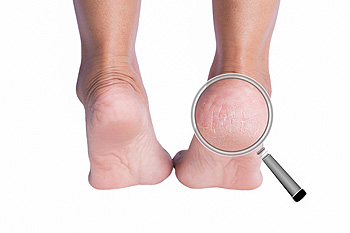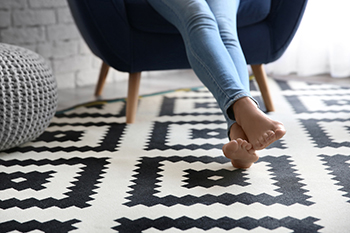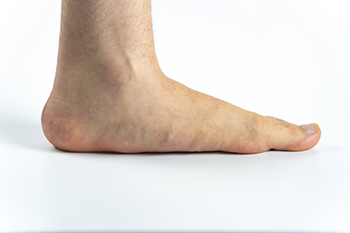Connect With Us
Blog
Do Your Child's Feet Hurt?
Treatment for Cracked Heels

Cracked heels are a common foot condition characterized by the splitting of dry, thick skin on the heels. When only the outer layer of skin is affected, it may not be painful but can be uncomfortable. In more severe cases, the cracks can extend into the healthy skin, causing pain, bleeding, and infection risk. Several factors contribute to cracked heels, including prolonged standing, wearing unsupportive footwear, and biomechanical issues. Additionally, taking hot showers, increase in weight, and medical conditions such as diabetes may contribute to developing cracked heels. They are often more prevalent in the summer due to wearing open-back shoes and warm weather. Symptoms of cracked heels often include discomfort, pain while standing, itchiness, and dry, white skin on the heels. Treatment involves removing the dry skin, addressing underlying problems or infections, and preventing recurrence. Prevention strategies include regular callus removal, daily moisturizing, and wearing appropriate footwear. If you are suffering from cracked heels and they are not responding to everyday foot care, it is suggested that you consult a podiatrist for a specialized treatment plan.
Cracked heels are unsightly and can cause further damage to your shoes and feet. If you have any concerns, contact Dr. Yeon A. Shim from Roselle Podiatry Group. Our doctor can provide the care you need to keep you pain-free and on your feet.
Cracked Heels
Cracked heels appear unappealing and can make it harder for you walk around in sandals. Aside from looking unpleasant, cracked heels can also tear stockings, socks, and wear out your shoes. There are several methods to help restore a cracked heel and prevent further damage.
How Do You Get Them?
Dry skin is the number one culprit in creating cracked heels. Many athletes, walkers, joggers, and even swimmers suffer from cracked heels. Age and skin oil production play a role to getting cracked heels as well.
Promote Healing
Over the counter medicines can help, especially for those that need instant relief or who suffer from chronic dry feet.
Wear Socks – Wearing socks with medicated creams helps lock in moisture.
Moisturizers – Applying both day and night will help alleviate dryness which causes cracking.
Pumice Stones – These exfoliate and remove dead skin, which allows for smoother moisturizer application and better absorption into the skin.
Change in Diet
Eating healthy with a well-balanced diet will give the skin a fresh and radiant look. Your body responds to the kinds of food you ingest. Omega-3 fatty acids and zinc supplements can also revitalize skin tissue.
Most importantly, seek professional help if unsure how to proceed in treating cracked heels. A podiatrist will help you with any questions or information needed.
If you have any questions, please feel free to contact our office located in Roselle, NJ . We offer the newest diagnostic and treatment technologies for all your foot care needs.
Managing a Broken Toe That Will Not Heal

A broken toe is a common injury, and can cause difficulty if it does not heal. Several factors can contribute to a broken toe that doesn’t mend as expected. Misdiagnosis can sometimes occur, where a toe injury may be more severe than initially believed. This may lead to a delayed diagnosis or inadequate treatment. Additionally, tiny hairline fractures, known as stress fractures, can be challenging to detect, and may not heal properly if not identified. Poor immobilization, with inadequately fitted splints or casts, can hinder the healing process. Medical conditions, such as diabetes or vascular disease, can slow down the healing process. Also, continuous stress on the broken toe, such as excessive walking or standing, can impede proper healing. Lastly, untreated or undetected infections in or around the broken toe can further obstruct the healing process. If you are dealing with a broken toe that does not seem to be healing, it is strongly suggested that you consult a podiatrist promptly. This medically trained foot doctor can identify the underlying cause and recommend a treatment plan appropriate to the cause.
Broken toes may cause a lot of pain and should be treated as soon as possible. If you have any concerns about your feet, contact Dr. Yeon A. Shim from Roselle Podiatry Group. Our doctor will treat your foot and ankle needs.
What Is a Broken Toe?
A broken toe occurs when one or more of the toe bones of the foot are broken after an injury. Injuries such as stubbing your toe or dropping a heavy object on it may cause a toe fracture.
Symptoms of a Broken Toe
- Swelling
- Pain (with/without wearing shoes)
- Stiffness
- Nail Injury
Although the injured toe should be monitored daily, it is especially important to have a podiatrist look at your toe if you have severe symptoms. Some of these symptoms include worsening or new pain that is not relieved with medication, sores, redness, or open wounds near the toe.
If you have any questions, please feel free to contact our office located in Roselle, NJ . We offer the newest diagnostic and treatment technologies for all your foot care needs.
Diabetic Foot Wounds

Diabetes affects the body's ability to heal foot wounds due to its impact on metabolizing glucose. High blood sugar levels hinder wound healing by preventing efficient nutrient and oxygen delivery, reducing immune system function, and increasing inflammation. Peripheral neuropathy, common in diabetes, can lead to reduced sensation in the feet, making foot wounds more prevalent. Poor circulation, often linked to diabetes, further impairs healing by reducing blood flow and affecting red blood cell function. Immune system deficiencies in diabetes hinder the body's ability to heal foot wounds and increase the risk of infection. Elevated blood sugar levels also promote bacterial growth, worsening the risk of infection. To aid in foot wound healing, performing regular self-foot checks are crucial in detecting wounds early. Removing dead tissue, keeping dressings fresh, and avoiding pressure on the wound can facilitate healing. If you experience symptoms such as tingling, burning, or persistent pain, or if your foot wound worsens, it is suggested that you make an appointment with a podiatrist as quickly as possible who can help you manage this serious condition.
Wound care is an important part in dealing with diabetes. If you have diabetes and a foot wound or would like more information about wound care for diabetics, consult with Dr. Yeon A. Shim from Roselle Podiatry Group. Our doctor will assess your condition and provide you with quality foot and ankle treatment.
What Is Wound Care?
Wound care is the practice of taking proper care of a wound. This can range from the smallest to the largest of wounds. While everyone can benefit from proper wound care, it is much more important for diabetics. Diabetics often suffer from poor blood circulation which causes wounds to heal much slower than they would in a non-diabetic.
What Is the Importance of Wound Care?
While it may not seem apparent with small ulcers on the foot, for diabetics, any size ulcer can become infected. Diabetics often also suffer from neuropathy, or nerve loss. This means they might not even feel when they have an ulcer on their foot. If the wound becomes severely infected, amputation may be necessary. Therefore, it is of the upmost importance to properly care for any and all foot wounds.
How to Care for Wounds
The best way to care for foot wounds is to prevent them. For diabetics, this means daily inspections of the feet for any signs of abnormalities or ulcers. It is also recommended to see a podiatrist several times a year for a foot inspection. If you do have an ulcer, run the wound under water to clear dirt from the wound; then apply antibiotic ointment to the wound and cover with a bandage. Bandages should be changed daily and keeping pressure off the wound is smart. It is advised to see a podiatrist, who can keep an eye on it.
If you have any questions, please feel free to contact our office located in Roselle, NJ . We offer the newest diagnostic and treatment technologies for all your foot care needs.
Wounds That Don't Heal Need to Be Checked
The Complex Anatomy of Your Feet and Ankles

Our feet and ankles are marvels of engineering, combining intricate structures to support our weight and facilitate movement. The remarkable anatomy of the foot consists of 26 bones, comprising the tarsal, metatarsal, and phalangeal bones, forming arches that provide stability and flexibility. Ligaments connect these bones, acting like tough rubber bands to hold the structure together. Meanwhile, muscles and tendons play a crucial role in moving the foot and toes. The ankle joint forms where the lower leg meets the foot, connecting the tibia and fibula to the talus bone. Ligaments here ensure stability, while the Achilles tendon at the back enables powerful movements, such as running and jumping. Understanding the intricate web of bones, ligaments, muscles, and tendons in your feet and ankles can help you appreciate their importance. If you would like additional knowledge about the biomechanics of the feet and ankles, it is suggested that you speak with a podiatrist.
If you have any concerns about your feet, contact Dr. Yeon A. Shim from Roselle Podiatry Group. Our doctor can provide the care you need to keep you pain-free and on your feet.
Biomechanics in Podiatry
Podiatric biomechanics is a particular sector of specialty podiatry with licensed practitioners who are trained to diagnose and treat conditions affecting the foot, ankle and lower leg. Biomechanics deals with the forces that act against the body, causing an interference with the biological structures. It focuses on the movement of the ankle, the foot and the forces that interact with them.
A History of Biomechanics
- Biomechanics dates back to the BC era in Egypt where evidence of professional foot care has been recorded.
- In 1974, biomechanics gained a higher profile from the studies of Merton Root, who claimed that by changing or controlling the forces between the ankle and the foot, corrections or conditions could be implemented to gain strength and coordination in the area.
Modern technological improvements are based on past theories and therapeutic processes that provide a better understanding of podiatric concepts for biomechanics. Computers can provide accurate information about the forces and patterns of the feet and lower legs.
Understanding biomechanics of the feet can help improve and eliminate pain, stopping further stress to the foot.
If you have any questions please feel free to contact our office located in Roselle, NJ . We offer the newest diagnostic and treatment technologies for all your foot and ankle needs.
How Walking and Running Shoes Differ

Choosing the right footwear helps to maintain foot health and prevent injuries. To make an informed choice, it's essential to understand the differences between walking and running shoes. For walkers, experts recommend lightweight shoes with extra shock absorption in the heel and under the ball of the foot. These features help reduce heel pain and discomfort in the ball of the foot. Some walkers prefer shoes with a rounded or rocker bottom, allowing for a smooth weight shift from heel to toe. Runners, however, should prioritize overall shock absorption and torsional strength in their shoes to guard against injuries like tendonitis, heel pain, and stress fractures. Ill-fitting or unsupportive shoes can cause or worsen issues such as toe pain, corns, bunions, ingrown toenails, and postural problems. Inappropriate shoes can also contribute to joint pain and stress caused by arthritis. If you have particular foot or ankle issues, it is suggested that you make an appointment with a podiatrist for help in finding the right shoes for your walking or running experience.
For more information about walking shoes versus running shoes, consult with Dr. Yeon A. Shim from Roselle Podiatry Group. Our doctor can measure your feet to determine what your needs are and help you find an appropriate pair of footwear.
Foot Health: The Differences between Walking & Running Shoes
There are great ways to stay in shape: running and walking are two great exercises to a healthy lifestyle. It is important to know that running shoes and walking shoes are not interchangeable. There is a key difference on how the feet hit the ground when someone is running or walking. This is why one should be aware that a shoe is designed differently for each activity.
You may be asking yourself what the real differences are between walking and running shoes and the answers may shock you.
Differences
Walking doesn’t involve as much stress or impact on the feet as running does. However, this doesn’t mean that you should be any less prepared. When you’re walking, you land on your heels and have your foot roll forward. This rolling motion requires additional support to the feet.
Flexibility – Walking shoes are designed to have soft, flexible soles. This allows the walker to push off easily with each step.
If you have any questions, please feel free to contact our office located in Roselle, NJ . We offer the newest diagnostic and treatment technologies for all your foot care needs.
Symptoms of Charcot-Marie-Tooth Disease

Charcot-Marie-Tooth disease is a cluster of inherited genetic disorders that impact the peripheral nervous system. These neuropathies disrupt the intricate network responsible for movement and sensation within the extremities, including the feet. The peripheral nervous system serves as a communication bridge between the brain, spinal cord, and muscles. Charcot-Marie-Tooth disease results in a range of symptoms that interfere with this process and dramatically influence foot health. Gradual muscle wasting in the feet and legs is a hallmark of this disease, causing increasing weakness and reduced control over time. This frequently leads to difficulties in mobility and balance. It also can result in high foot arches, known as pes cavus, and clawed toes. These structural changes can further impede proper foot function and comfort. An altered gait, often high-stepping, and a slapping sound when walking are only some of the common symptoms. Poor balance and a risk of falling are others, caused by weakened muscles and loss of sensation. Although there is no cure, it is possible to manage foot-related challenges and potentially slow down the progression of the disease. For guidance, it is suggested that you make an appointment with a podiatrist.
When dealing with systemic disease of the feet, it is extremely important to check the affected areas routinely so that any additional problems are caught quickly. If you have any concerns about your feet and ankles contact Dr. Yeon A. Shim from Roselle Podiatry Group. Our doctor will assist you with all of your podiatric needs.
Systemic Diseases of the Feet
Systemic diseases affect the whole body, and symptoms usually are displayed in the feet. This condition can make a patient’s ability to walk unbearable. Systemic diseases include gout, diabetes mellitus, neurological disorders, and arthritis.
Gout – is caused by an excess of uric acid in the body. Common symptoms include pain, inflammation, and redness at the metatarsal/phalangeal joint of the base big toe. Gout can be treated by NSAIDs to relieve pain and inflammation, and other drugs that lower the acid levels in the body.
Diabetes mellitus – is an increase in the level of blood sugar that the body cannot counteract with its own insulin. Failure to produce enough insulin is a factor in Diabetes.
Diabetes of the Feet
Diabetic Neuropathy – may lead to damaged nerves and affect the feet through numbness and loss of sensation.
Peripheral Vascular Disease – can restrict the blood flow to the feet, and often times lead to amputation of the feet.
If you have any questions please feel free to contact our office located in Roselle, NJ . We offer the newest diagnostic and treatment technologies for all your foot and ankle needs.
It's Time for Beautiful Feet
Treating and Preventing Plantar Warts

Plantar warts are stubborn growths caused by human papillomavirus, abbreviated HPV, and can be a source of discomfort and frustration. If you are attempting to manage these types of warts, there are effective ways to address them. Over-the-counter treatments containing salicylic acid can help dissolve the warts over time. Alternatively, your podiatrist can use cryotherapy to freeze the warts off. It is important to avoid picking or scratching the warts, as this can spread the virus. To help prevent plantar warts, keep your feet dry and clean, especially in damp environments, such as locker rooms or public showers. Wearing appropriate shoes, such as flip-flops, in communal areas can help to reduce the risk of exposure. If you have developed a plantar wart, it is suggested that you consult with a podiatrist who can guide you toward the treatment method that is right for you.
Plantar warts can be very uncomfortable. If you need your feet checked, contact Dr. Yeon A. Shim from Roselle Podiatry Group. Our doctor will assist you with all of your foot and ankle needs.
About Plantar Warts
Plantar warts are the result of HPV, or human papillomavirus, getting into open wounds on the feet. They are mostly found on the heels or balls of the feet.
While plantar warts are generally harmless, those experiencing excessive pain or those suffering from diabetes or a compromised immune system require immediate medical care. Plantar warts are easily diagnosed, usually through scraping off a bit of rough skin or by getting a biopsy.
Symptoms
- Lesions on the bottom of your feet, usually rough and grainy
- Hard or thick callused spots
- Wart seeds, which are small clotted blood vessels that look like little black spots
- Pain, discomfort, or tenderness of your feet when walking or standing
Treatment
- Freezing
- Electric tool removal
- Laser Treatment
- Topical Creams (prescription only)
- Over-the-counter medications
To help prevent developing plantar warts, avoid walking barefoot over abrasive surfaces that can cause cuts or wounds for HPV to get into. Avoiding direct contact with other warts, as well as not picking or rubbing existing warts, can help prevent the further spread of plantar warts. However, if you think you have developed plantar warts, speak to your podiatrist. He or she can diagnose the warts on your feet and recommend the appropriate treatment options.
If you have any questions please feel free to contact our office located in Roselle, NJ . We offer the newest diagnostic and treatment technologies for all your foot and ankle needs.
More...
Understanding Causes and Symptoms of Adult Flat Feet

Adult flat feet stand as a prevalent and often misunderstood condition. Defined as the partial or complete collapse of the foot's arch, this issue can lead to discomfort and altered gait patterns. Various factors contribute to flat feet, including genetic predisposition, injury, or conditions such as posterior tibial tendon dysfunction. Symptoms may range from pain and swelling along the inner ankle to general foot fatigue. Uneven shoe wear and difficulty fitting into certain footwear may also signal this condition. While some adults can live with flat feet without discomfort, others may experience pain and difficulty in completing daily activities. Gaining a complete understanding of the causes and symptoms of adult flat feet can empower affected individuals to seek appropriate medical advice. If you have flat feet, it is suggested that you are under the care of a podiatrist who can help you to manage this condition.
Flatfoot is a condition many people suffer from. If you have flat feet, contact Dr. Yeon A. Shim from Roselle Podiatry Group. Our doctor will treat your foot and ankle needs.
What Are Flat Feet?
Flatfoot is a condition in which the arch of the foot is depressed and the sole of the foot is almost completely in contact with the ground. About 20-30% of the population generally has flat feet because their arches never formed during growth.
Conditions & Problems:
Having flat feet makes it difficult to run or walk because of the stress placed on the ankles.
Alignment – The general alignment of your legs can be disrupted, because the ankles move inward which can cause major discomfort.
Knees – If you have complications with your knees, flat feet can be a contributor to arthritis in that area.
Symptoms
- Pain around the heel or arch area
- Trouble standing on the tip toe
- Swelling around the inside of the ankle
- Flat look to one or both feet
- Having your shoes feel uneven when worn
Treatment
If you are experiencing pain and stress on the foot you may weaken the posterior tibial tendon, which runs around the inside of the ankle.
If you have any questions please feel free to contact our office located in Roselle, NJ . We offer the newest diagnostic and treatment technologies for all your foot and ankle needs.
Common Reasons for Big Toe Pain

The foot is a complex structure that contains numerous tendons, ligaments, muscles, and bones, with 19 bones located in the toes themselves. Among the common causes of toe pain are gout, tendonitis, bunions, and osteoarthritis. Rheumatoid arthritis, sesamoiditis, and turf toe are other causes. Gout is a type of arthritis caused by too much uric acid in the system, leading to excruciating big toe pain. Overuse of the big toe, which is instrumental in walking, can lead to inflammation of the big toe joint. Tight-fitting shoes can cause a bump to develop at the base of the big toe, known as a bunion. Pain results from a shift in the biomechanics of the feet and friction caused by shoes. Rheumatoid arthritis can also lead to bunion-like deformities, causing sharp pain. Trauma to the big toe can also trigger osteoarthritis, which is characterized by excessive wear and tear of the toe joints. Sesamoiditis is an inflammation of the tissue surrounding the two tiny sesamoid bones, located at the base of the big toe. Turf toe, an overstretching of the ligament at the base of the big toe. For assistance with big toe pain that is limiting your daily activities, it is suggested that you make an appointment with a podiatrist.
Toe pain can disrupt your daily activities. If you have any concerns, contact Dr. Yeon A. Shim of Roselle Podiatry Group. Our doctor can provide the care you need to keep you pain-free and on your feet.
What Causes Toe Pain?
Most severe toe pain is caused due to a sports injury, trauma from dropping something heavy on the toe, or bumping into something rigid. Other problems can develop over time for various reasons.
Toe pain can be caused by one or more ailments. The most common include:
- Trauma
- Sports injury
- Wearing shoes that are too tight
- Arthritis
- Gout
- Corns and calluses
- Hammertoe
- Bunions
- Blisters
- Ingrown toenails
- Sprains
- Fractures (broken bones)
- Dislocations
When to See a Podiatrist
- Severe pain
- Persistent pain that lasts more than a week
- Signs of infection
- Continued swelling
- Pain that prevents walking
Diagnosis
In many cases the cause of toe pain is obvious, but in others, a podiatrist may want to use more advanced methods to determine the problem. These can range from simple visual inspections and sensation tests to X-rays and MRI scans. Prior medical history, family medical history, and any recent physical traumatic events will all be taken into consideration for a proper diagnosis.
Treatment
Treatments for toe pain and injuries vary and may include shoe inserts, padding, taping, medicines, injections, and in some cases, surgery. If you believe that you have broken a toe, please see a podiatrist as soon as possible.
If you have any questions please feel free to contact our office located in Roselle, NJ . We offer the newest diagnostic tools and technology to treat your foot and ankle needs.
Heel Pain Can Be Treated!
Socks Help Protect the Feet From Running Injuries

Much attention is placed on finding the proper running shoes for your feet and the type of running you will be doing. However, finding the right socks can be equally important to avoid discomfort and injury while running. The right running socks can help to prevent blisters, pad the feet, offer support, and wick away moisture. Running socks have certain attributes that normal socks don’t have. First, they are seamless, which can help to eliminate the rubbing and friction that encourages the formation of blisters. Second, while wearing running socks may not be the same as having insoles, many will contain a compression band that adds support and improves the fit. Third, many running socks also include cushioning for the ball of the foot and the heel. Finally, double-layer socks absorb the friction between the layers rather than on the skin. For more help with this and other ways to prevent running injuries, it is suggested that you make an appointment with a podiatrist.
All runners should take extra precaution when trying to avoid injury. If you have any concerns about your feet, contact Dr. Yeon A. Shim of Roselle Podiatry Group. Our doctor will treat your foot and ankle needs.
How to Prevent Running Injuries
There are a lot of mistakes a runner can make prior to a workout that can induce injury. A lot of athletes tend to overstretch before running, instead of saving those workouts for a post-run routine. Deep lunges and hand-to-toe hamstring pulls should be performed after a workout instead of during a warmup. Another common mistake is jumping into an intense routine before your body is physically prepared for it. You should try to ease your way into long-distance running instead of forcing yourself to rush into it.
More Tips for Preventing Injury
- Incorporate Strength Training into Workouts - This will help improve the body’s overall athleticism
- Improve and Maintain Your Flexibility – Stretching everyday will help improve overall performance
- “Warm Up” Before Running and “Cool Down” Afterward – A warm up of 5-10 minutes helps get rid of lactic acid in the muscles and prevents delayed muscle soreness
- Cross-Training is Crucial
- Wear Proper Running Shoes
- Have a Formal Gait Analysis – Poor biomechanics can easily cause injury
If you have any questions, please feel free to contact our office located in Roselle, NJ . We offer the newest diagnostic and treatment technologies for all your foot care needs.





